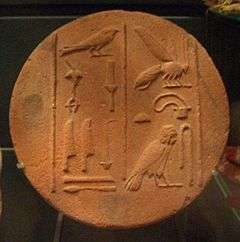Funerary cone
Funerary cones were small cones made from clay that were used in Ancient Egypt, almost exclusively in the Theban necropolis.[1] The items were placed over the entrance of the chapel of a tomb. Early examples have been found from the Eleventh Dynasty. However, they are generally undecorated. During the New Kingdom, the cones were smaller in size and inscribed in hieroglyphs with the title and name of the tomb owner, often with a short prayer.
The exact purpose of the cones is unknown.[2]
| Views of funerary cones |
|---|
| Base of cone, containing two columns of hieroglyphs in registers. (Excellent condition; note seal-with-cording, and vertical drill for stone pots. Deserving, or 'True of Voice'-(for the deceased) ends the reading, at column 1-(from right, column 2, then column 1).) |
| Several cones, New Empire. |
|
See also
External links
Further reading
- Zenihiro, Kento (2009). The Complete Funerary Cones. Self-published. ISBN 978-4-89630-246-2.
References
